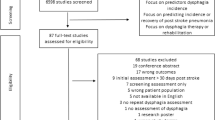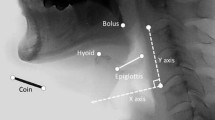Abstract
The purpose of this study was to investigate the relationship between prolonged stage transition duration (STD) and aspiration. STDs and aspiration ratings were made from videofluoroscopic examinations previously obtained for other studies. Three groups of subjects were examined: (1) 20 stroke patients who aspirated, (2) 31 stroke patients who did not aspirate, and (3) 15 normal subjects. Aspirators poststroke had the longest STD of the three groups. Furthermore, results indicated that STD correctly predicted the presence of aspiration 75% of the time and correctly predicted the absence of aspiration in stroke patients 93% of the time. Nonaspirating stroke participants had similar patterns to the normal subjects. Implications for these findings are discussed.


Similar content being viewed by others
References
Logemann JA: Evaluation and Treatment of Swallowing Disorders. Austin, TX: Pro-Ed, 1998
Cook IJ, Dodds WJ, Dantas RO, Kern MK, Massey BT, Shaker R, Hogan WJ: Timing of videofluoroscopic, manometric events, and bolus transit timing during the oral and pharyngeal phases of swallowing. Dysphagia 4:8–15, 1989
Robbins JA, Hamilton JW, Lof GL, Kempster GB: Oropharyngeal swallowing in normal adults of different ages. Gastroenterology 103:823–829, 1992
Robbins JA, Levine RL: Swallowing after unilateral stroke of the cerebral cortex: preliminary experience. Dysphagia 3:11–17, 1998
Kim Y, McCullough GH, Asp CW: Temporal measurements of pharyngeal swallowing in normal populations. Dysphagia 20:290–296, 2005
McCullough GH, Wertz RT, Rosenbek JC: Sensitivity and specificity of clinical/bedside examination signs for detecting aspiration in adults subsequent to stroke. J Commun Disord 34:55–72, 2001
McCullough GH, Wertz RT, Rosenbek JC: Age, Gender, Size, Consistency Effects on Swallowing Function in Adults Between 21 and 99 Years of Age. Presented at the 10th annual meeting of Dysphagia Research Society, Albuquerque, NM, 2001
Langmore SE, Terpenning MS, Schork A, Chen Y, Murray JT, Lopatin D, Loesche WJ: Predictors of aspiration pneumonia: how important is dysphagia? Dysphagia 13(2):69–81, 1998
Holas MA, DePippo KL, Reding MJ: Aspiration and relative risk of medical complications following stroke. Arch Neurol 51(10):1051–1053, 1994
Groher ME: The detection of aspiration and videofluoroscopy. Dysphagia 9:147–148, 1994
Crary MA, Baldwin BO: Surface electromyographic characteristics of swallowing in dysphagia secondary to brainstem stroke. Dysphagia 12(4):180–187, 1997
Bisch EM, Logemann JA, Rademaker AW, Kahrilas PJ, Lazarus CL: Pharyngeal effects of bolus volume, viscosity, and temperature in patients with dysphagia resulting from neurologic impairment and in normal subjects. J Speech Hear Res 37(5):1041–1059, 1994
Rosenbek JC, Robbins J, Fishback B, Levine RL: Effects of thermal application on dysphagia after stroke. J Speech Hear Res 34(6):1257–1268, 1991
Welch MV, Logemann JA, Rademaker AW, Kahrilas PJ: Changes in pharyngeal dimensions effected by chin tuck. Arch Phys Med Rehabil 74(2):178–181, 1993
Acknowledgments
This work was made possible in part by a grant from the Department of Veterans Affairs Office of Academic Affiliations and a grant from the Department of Veterans Affairs.
Author information
Authors and Affiliations
Corresponding author
Rights and permissions
About this article
Cite this article
Kim, Y., McCullough, G.H. Stage Transition Duration in Patients Poststroke. Dysphagia 22, 299–305 (2007). https://doi.org/10.1007/s00455-007-9085-4
Published:
Issue Date:
DOI: https://doi.org/10.1007/s00455-007-9085-4




